Selected Aspects of Sustainable Construction—Contemporary Opportunities for the Use of Timber in High and High-Rise Buildings
Abstract
:1. Introduction
1.1. Background
- “Reduce”—reduce the consumption of building materials, natural resources, and energy required to construct a building.
- “Reuse”—the reuse of construction materials or pieces of fittings, etc.
- “Recycle”—processing waste materials and reusing them.
- “Refuse”—refusing to accept goods in single-use packaging and promoting the use of reusable packaging.
- “Repurpose”—repurposing waste materials, also called upcycling.
- Energy and water demand in all phases of a building’s life.
- Materials used in construction, finishing and furnishing, repairs, and renovations.
- The overall management of waste (including construction waste), its storage, treatment, separation, etc.
- The environmental impact of construction works, including biologically active areas.
- Transport related to the investment process of constructing a building and transport related to meeting the needs of building users.
- Costs relating to the entire life cycle of the building, including the investment process, operation, environmental, and economic costs.
- The first relates to the sourcing/extraction of raw materials, transport to the production facility, manufacture of the building material, and incorporation into the building. During this phase, there are many factors that have a negative impact on the environment, i.e., depletion of natural resources, land use due to the construction of a new building, use of industrial infrastructure, generation of waste, emissions from transport, machinery, and equipment, consumption of the so-called “embedded energy”, etc.
- The second relates to the operation and construction work (identical to phase one) associated with ongoing maintenance, repairs, possible alterations in construction, extensions, superstructures, etc., and the consumption of operational energy for heating, ventilation, air conditioning, lighting, electricity to power other appliances and equipment, etc. [14].
- The third phase is final disposal, i.e., demolition, recycling, and disposal. During this phase, there are factors adversely affecting the environment due to dust and gas emissions, the consumption of so-called processing energy related to transport, the operation of construction machinery and equipment, waste treatment, and management. During this phase, it is important to try to recover the materials used in a building and recycle, reuse, or change their function and reuse them [2,9,15].
1.2. Goals and Scope
- Limiting interference with natural urban areas—through efficient use of the building plot for high or high-rise buildings;
- the use of renewable, recyclable materials for constructing the load-bearing structure of buildings—timber meets this requirement.
2. Materials and Methods
2.1. The Complex of Four Limnologen Residential Buildings in Vaxjo
2.1.1. Spatial and Functional Solution
2.1.2. Material and Construction Solution
2.2. A Complex of Two Residential Buildings in Portvakten Söder
2.2.1. Spatial and Functional Solution
2.2.2. Material and Construction Solution
2.3. Stadthaus Building in London
2.3.1. Spatial and Functional Solution
2.3.2. Material and Construction Solution
2.4. Building B of the Building Complex Strandparken in Sundbyberg
2.4.1. Spatial and Functional Solution
2.4.2. Material and Construction Solution
2.5. Building “Wood Innovation Design Centre” in Prince George
2.5.1. Spatial and Functional Solution
2.5.2. Material and Construction Solution
2.6. Residential Complex in the Vallen District of the Town of Vaxjo
2.6.1. Spatial and Functional Solution
2.6.2. Material and Construction Solution
2.7. Brock Commons Dormitory in Vancouver
2.7.1. Spatial and Functional Solution
2.7.2. Material and Construction Solution
2.8. Dalston Works Compact Residential Complex in Hackney in London
2.8.1. Spatial and Functional Solution
2.8.2. Material and Construction Solution
2.9. The Carbon 12 Building in Portland
2.9.1. Spatial and Functional Solution
2.9.2. Material and Construction Solution
2.10. “Perspective” Office Building in Bordeaux
2.10.1. Spatial and Functional Solution
2.10.2. Material and Construction Solution
2.11. The Complex of Buildings Puukuokka One, Two, and Three in Jyväskylä
2.11.1. Spatial and Functional Solution
2.11.2. Material and Construction Solution
2.12. Arbo Office Building in Lucerne
2.12.1. Spatial and Functional Solution
2.12.2. Material and Construction Solution
2.13. Mjøstårnet Building in Brumunddal
2.13.1. Spatial and Functional Solution
2.13.2. Material and Construction Solution
2.14. The HoHo Building in Vienna
2.14.1. Spatial and Functional Solution
2.14.2. Material and Construction Solution
2.15. Sara Kulturhus Center Buildings in Skellefteå
2.15.1. Spatial and Functional Solution
2.15.2. Material and Construction Solution
2.16. Haut Residential Building in Amsterdam
2.16.1. Spatial and Functional Solution
2.16.2. Material and Construction Solution
2.17. Tallwood 1 Building in Langford
2.17.1. Spatial and Functional Solution
2.17.2. Material and Construction Solution
2.18. The Ascent MKE in Milwaukee
2.18.1. Spatial and Functional Solution
2.18.2. Material and Construction Solution
2.19. The T3 Bayside East Building in Toronto
2.19.1. Spatial and Functional Solution
2.19.2. Material and Construction Solution
3. Results
3.1. Results of Spatial–Functional Solution Analyses
- The use of renewable materials with low embedded energy (needed for the production of the material) and recyclability. All analysed buildings have a load-bearing superstructure made of CLT or GLT, and a significant part of their finishes, i.e., façade cladding, ceilings, or internal walls, are made of CLT or cedar wood shingles.
- The use of structural solutions that are easy to dismantle and possibly erect in another location; e.g., Puukuokka buildings One, Two, and Three.
- The use of local materials and the consequent energy savings resulting from their reduced transport needs. Building structure and building fittings: Limnologen, Portvakten Söder, Strandparken, Wood Innovation Design Centre, Vallen, Carbon 12 w Portland, Perspective, Puukuokka One, Two, and Three, and Mjøstårnet were made of timber from local or national forest resources.
- Taking into account already in the spatial–functional design phase the possibility of the adaptation of buildings to new needs, resulting in better use of the existing building fabric and limiting the sprawl of built-up areas. The design of, e.g., the T3 Bayside East building has taken into account the possibility of adaptation to a new function in case the original function is exhausted.
- Environment protection, including, inter alia, through the efficient management of building plots for high and high-rise development, consequently preserving to a greater extent natural areas in urban territory in relation to extensive development (low-rise buildings). All the buildings analysed meet the mentioned requirements.
- The use of recycled materials; e.g., 70% of the facades of the Stadthaus building are clad with recycled timber cladding.
- Adapting the scale of buildings to meet the needs of the community, including, among other things, by introducing a diversified offer of residential apartments and providing the possibility of “flexible” interior design in accordance with the tenant’s expectations. All the buildings analysed meet the mentioned requirements.
- Well-chosen orientation of the building block with respect to the sides of the world in order to make better use of energy and sunlight. All the buildings analysed meet the mentioned requirements.
- Appropriate choice of building location to ensure convenient access to public transport and consequently reduce the need to use individual transport; e.g., Buildings: Carbon12, Tallwood 1.
- Saving water through the introduction of systems for the recovery and management of so-called “grey water” and harvesting water, e.g., rainwater; this issue has not been taken into account in this article.
- Reduced utility costs through the use of efficient energy sources, including renewables as a dominant energy source; the analyses of this issue have not been taken into account in this article.
3.2. Results of Analyses of Material and Construction Solutions
3.2.1. Foundation and Underground Part
3.2.2. Material and Construction Solution for the Above-Ground Part
- Bars (mullions and beams) made of GLT-glued laminated timber or LVL laminated veneer lumber.
- Surface panels (wall panels, ceiling panels, and stairway panels) made of CLT cross-laminated timber.
- Spatial made of cross-laminated timber CLTs with a volume equivalent to the volume of a hotel room (e.g., the Sara Kulturhus Centre building) or part of an apartment (e.g., a spatial module containing a living room, balcony, and bedroom), i.e., in the spatial–functional solutions of Puukuokka One, Two, and Three buildings.
3.2.3. Construction of Vertical Communication Structures
4. Discussion
5. Conclusions
Author Contributions
Funding
Data Availability Statement
Conflicts of Interest
References
- Bać, A. Zrównoważenie w Architekturze. Od Idei do Realizacji na Tle Doświadczeń Kanadyjskich (Sustainability in Architecture. From Idea to Implementation against the Background of the Canadian Experience); Oficyna Wydawnicza Politechniki Wrocławskiej: Wrocław, Poland, 2016. [Google Scholar]
- Michalak, H.; Torberntsson, A. Koncepcje ograniczania negatywnego oddziaływania na środowisko naturalne w projektowaniu i realizacji budynków (Concepts of reducing negative environmental impact in designing and implementation in building industry). Mater. Bud. 2023, 608, 20–24. [Google Scholar] [CrossRef]
- Leslie, C.M.; Strand, A.I.; Ross, E.A.; Ramos, G.T.; Bridge, E.S.; Chilson, P.B.; Anderson, C.E. Shifting the Balance among the ‘Three Rs of Sustainability:’ What Motivates Reducing and Reusing? Sustainability 2021, 13, 10093. [Google Scholar] [CrossRef]
- Kabirifar, K.; Mojtahedi, M.; Wang, C.; Tam, V.W.Y. Construction and demolition waste management contributing factors coupled with reduce, reuse, and recycle strategies for effective waste management: A Review. J. Clean. Prod. 2020, 263, 121265. [Google Scholar] [CrossRef]
- Tserng, H.-P.; Chou, C.-M.; Chang, Y.-T. The Key Strategies to Implement Circular Economy in Building Projects—A Case Study of Taiwan. Sustainability 2021, 13, 754. [Google Scholar] [CrossRef]
- The Importance of the 5Rs of Waste Management. Available online: https://cleanmanagement.com/blog/the-importance-of-the-5rs-of-waste-management/ (accessed on 17 February 2024).
- Rezolucja Zgromadzenia Ogólnego A/RES/70/1: Agenda na Rzecz Zrównoważonego Rozwoju 2030. Available online: https://www.un.org.pl/agenda-2030-rezolucja (accessed on 17 February 2024).
- Edwards, B. Sustainable Architecture: European Directives and Building Design, 2nd ed.; Architectural Press: Oxford, UK, 1999. [Google Scholar]
- Borkowski, M. Ocena cyklu istnienia obiektów na przykładzie budownictwa jednorodzinnego (Life-cycle assessment of structures using single-family housing as an example). Przegląd Bud. 2015, 3, 15–21. [Google Scholar]
- Larsson, M.; Erlandsson, M.; Malmqvist, T.; Kellner, J. Climate Impact of Constructing an Apartment Building with Exterior Walls and Frames of Cross-Laminated Timber—The Strandparken Residential Tower. IVL Swedish Environmental Research Institute 2017. Available online: https://www.diva-portal.org/smash/get/diva2:1552350/FULLTEXT01.pdf (accessed on 17 February 2024).
- Yang, H.; Kikuta, K.; Hayashi, M. Research on the Whole Lifecycle Emission Reduction Effect of Buildings with Different Structures in Severely Cold Regions—A Case Study in China. Energies 2023, 16, 5285. [Google Scholar] [CrossRef]
- Toroxel, J.L.; Silva, S.M. A Review of Passive Solar Heating and Cooling Technologies Based on Bioclimatic and Vernacular Architecture. Energies 2024, 17, 1006. [Google Scholar] [CrossRef]
- Pierzchalski, M.; Ryńska, E.D.; Węglarz, A. Life Cycle Assessment as a Major Support Tool within Multi-Criteria Design Process of Single Dwellings Located in Poland. Energies 2021, 14, 3748. [Google Scholar] [CrossRef]
- Marchwiński, J.; Starzyk, A.; Kopyłow, O. Kontekst energetyczny wykorzystania materiałów budowlanych w projektowaniu energoefektywnych budynków przedszkolnych—Spojrzenie architektoniczne (Energy context of building materials’ use in designing energy-efficient kindergarten buildings—Architectural outlook). Mater. Bud. 2022, 6, 34–38. [Google Scholar] [CrossRef]
- Geryło, R. Wskaźniki energetyczne w ocenie środowiskowej budynków i wyrobów budowlanych (Energy indicators in the environmental assessment of buildings and construction products). Przegląd Bud. 2017, 10, 13–14. Available online: https://yadda.icm.edu.pl/baztech/element/bwmeta1.element.baztech-3d3e3110-485e-4c3f-b764-7134b67ec8ba/c/Gerylo_Wskazniki_10_2017.pdf (accessed on 17 February 2024).
- Mahapatra, K.; Olsson, S. Energy Performance of Two Multi-Story Wood-Frame Passive Houses in Sweden. Buildings 2015, 5, 1207–1220. [Google Scholar] [CrossRef]
- Akintayo, B.D.; Ige, O.E.; Babatunde, O.M.; Olanrewaju, O.A. Evaluation and Prioritization of Power-Generating Systems Using a Life Cycle Assessment and a Multicriteria Decision-Making Approach. Energies 2023, 16, 6722. [Google Scholar] [CrossRef]
- Dylewski, R.; Adamczyk, J. Economic and Ecological Optimization of Thermal Insulation Depending on the Pre-Set Temperature in a Dwelling. Energies 2023, 16, 4174. [Google Scholar] [CrossRef]
- Alapieti, T.; Mikkola, R.; Pasanen, P.; Salonen, H. The influence of wooden interior materials on indoor environment: A review. Eur. J. Wood Prod. 2020, 78, 617–634. [Google Scholar] [CrossRef]
- Samudrala, M.; Mujeeb, S.; Lanjewar, B.A.; Chippagiri, R.; Kamath, M.; Ralegaonkar, R.V. 3D-Printable Concrete for Energy-Efficient Buildings. Energies 2023, 16, 4234. [Google Scholar] [CrossRef]
- Motamedi, S.; Rousse, D.R.; Promis, G. The Evolution of Crop-Based Materials in the Built Environment: A Review of the Applications, Performance, and Challenges. Energies 2023, 16, 5252. [Google Scholar] [CrossRef]
- Płoszaj-Mazurek, M.; Ryńska, E.; Grochulska-Salak, M. Methods to Optimize Carbon Footprint of Buildings in Regenerative Architectural Design with the Use of Machine Learning, Convolutional Neural Network, and Parametric Design. Energies 2020, 13, 5289. [Google Scholar] [CrossRef]
- Marchwiński, J.; Zielonko-Jung, K. Współczesna Architektura Proekologiczna (Contemporary Eco-Friendly Architecture); Wydawnictwo Naukowe PWN: Warsaw, Poland, 2012. [Google Scholar]
- Rozporządzenie Ministra Infrastruktury z dnia 12 Kwietnia 2002 r. w Sprawie Warunków Technicznych, Jakim Powinny Odpowiadać Budynki i Ich Usytuowanie (Regulation of the Minister for Infrastructure of 12 April 2002 on the Technical Conditions to Be Met by Buildings and Their Location). Dz.U. 2022 poz. 1225. Available online: https://isap.sejm.gov.pl/isap.nsf/DocDetails.xsp?id=WDU20220001225 (accessed on 17 February 2024).
- Landel, P. Swedish Technical Benchmarking of Tall Timber Buildings. Technical Report November 2018. RISE Research Institutes of Sweden Report 2018:67. Available online: https://www.researchgate.net/publication/331684721 (accessed on 17 February 2024).
- Serrano, E. Limnologen—Experiences from an 8-Storey Timber Building. 15. Internationales Holzbau-Forum, Technical Report January 2009; Sweden, 1–12. Available online: https://www.researchgate.net/publication/266000534_Documentation_of_the_Limnologen_Project_Overview_and_Summaries_of_Sub_Projects_Results (accessed on 17 February 2024).
- Waugh Thistleton Architects, Stadthaus. Archello. Available online: https://archello.com/project/stadthaus (accessed on 17 February 2024).
- Wood Awards. The Stadthaus. Available online: https://www.woodawards.com/portfolio/the-stadthaus/ (accessed on 17 February 2024).
- Prince George, BC Wood Innovation and Design Centre. A Technical Case Study. Available online: https://wood-works.ca/wp-content/uploads/151203-WoodWorks-WIDC-Case-Study-WEB.pdf (accessed on 16 February 2024).
- Hooper, E. Innovative Detail: Wood Innovation and Design Centre. Architect Magazine. Available online: https://www.architectmagazine.com/technology/architectural-detail/innovative-detail-wood-innovation-and-design-centre_o (accessed on 16 February 2024).
- University of Northern British Columbia. The Wood Innovation and Design Centre. Available online: https://www2.unbc.ca/engineering/wood-innovation-and-design-centre (accessed on 16 February 2024).
- Binderholz, Reference. Residential Complex Vallen, Växjö|Sweden. Available online: https://www.binderholz.com/en-us/mass-timber-solutions/residential-complex-vallen-vaexjoe-sweden/ (accessed on 16 February 2024).
- Brock Commons Tallwood House: Construction Modelling. Available online: https://www.naturallywood.com/wp-content/uploads/brock-commons-construction-modelling_case-study_naturallywood.pdf (accessed on 16 February 2024).
- Hasan, Z.G. Inside Vancouver’s Brock Commons, the World’s Tallest Mass Timber Building. ArchDaily. Available online: https://www.archdaily.com/879625/inside-vancouvers-brock-commons-the-worlds-tallest-timber-structured-building (accessed on 20 February 2024).
- Gintoff, V. Construction of the World’s Tallest Timber Tower is Underway in Vancouver. ArchDaily. Available online: https://www.archdaily.com/787673/construction-of-the-worlds-tallest-timber-tower-is-underway-in-vancouver (accessed on 20 February 2024).
- Crockett, L. World’s Tallest Timber Tower” Tops Out in Vancouver. ArchDaily. Available online: https://www.archdaily.com/794170/worlds-tallest-timber-tower-tops-out-in-vancouver (accessed on 20 February 2024).
- Merrick, J. High Density, Low Carbon: Dalston Works by Waugh Thistleton. Architects’ Journal. Available online: https://www.architectsjournal.co.uk/buildings/high-density-low-carbon-dalston-works-by-waugh-thistleton (accessed on 20 February 2024).
- Waugh Thistleton Architects. Dalston Works. The World’s Largest CLT Building. Available online: https://waughthistleton.com/dalston-works/ (accessed on 20 February 2024).
- Englefield, J. Dalston Works Demonstrated that “Timber Is a Viable Alternative to Concrete and Steel at Scale. Available online: https://www.dezeen.com/2023/03/23/dalston-works-waugh-thistleton-architects-timber-revolution/ (accessed on 20 February 2024).
- Carbon12, an 8 Story Wood Building, Proposed for N Williams. Available online: https://www.nextportland.com/2015/05/14/carbon12/ (accessed on 20 February 2024).
- Andrews, G. Wood: The Sky’s the Limit. Available online: https://djcoregon.com/news/2017/03/08/wood-the-skys-the-limit/ (accessed on 17 February 2024).
- Architects—Nicolas Laisné. Perspective Bordeaux, France. Available online: https://nicolaslaisne.com/en/portfolio_page/perspective-en/ (accessed on 17 February 2024).
- Perspective, L’immeuble Tertiaire en Structure Bois le Plus Haut de FRANCE. Available online: https://www.cahiers-techniques-batiment.fr/article/perspective-l-immeuble-tertiaire-en-structure-bois-le-plus-haut-de-france.38244 (accessed on 17 February 2024).
- Immeuble “Perspective” Bordeaux (33) Offices. Available online: https://www.france-douglas.com/galerie-des-realisations/immeuble-perspective.html (accessed on 17 February 2024).
- OOPEAA, Puukuokka Housing Block. Available online: https://oopeaa.com/portfolio/puukuokka-housing-block/ (accessed on 17 February 2024).
- Jyväskylä—Wooden Apartment Building.jpg. Available online: https://commons.wikimedia.org/wiki/File:Jyv%C3%A4skyl%C3%A4_-_wooden_apartment_building.jpg (accessed on 17 February 2024).
- Lassila, A. Wood Architecture|Block of Flats Puukuokka Housing Block. Available online: https://puuinfo.fi/arkkitehtuuri/block-of-flats/puukuokka-housing-block/?lang=en (accessed on 19 February 2024).
- OOPEAA. Puukuokka As Study Case On Decarbonized Construction. Available online: https://oopeaa.com/puukuokka-as-study-case-on-decarbonized-construction/ (accessed on 20 February 2024).
- Jockwer, R.; Grönquist, P.; Frangi, A. Long-term Deformation Behaviour of Timber Columns: Monitoring of a Tall Timber Building in Switzerland. Eng. Struct. 2021, 234, 111855. [Google Scholar] [CrossRef]
- Abrahamsen, R. Mjøstårnet—Construction of an 81 m Tall Timber Building. 23. Internationales Holzbau-Forum IHF 2017. Available online: https://www.moelven.com/globalassets/moelven-limtre/mjostarnet/mjostarnet---construction-of-an-81-m-tall-timber-building.pdf (accessed on 21 February 2024).
- Mjøsa Tower o “Mjøstårnet”: L’edificio in Legno più Alto al Mondo. Available online: https://ecologico.altervista.org/mjosa-tower-o-mjostarnet-ledificio-in-legno-piu-alto-al-mondo/ (accessed on 17 February 2024).
- Narsotårnet IV.jpg. Available online: https://en.m.wikipedia.org/wiki/File:Narsot%C3%A5rnet_IV.jpg (accessed on 21 February 2024).
- Triple Wood/Projects/02, Multistorey Buildings HoHo Wien Vienna, Austria. Available online: https://www.triplewood.eu/projects/hoho-wien (accessed on 21 February 2024).
- HoHo Wien Vienna 19-20 IMG 2225.jpg. Available online: https://en.m.wikipedia.org/wiki/File:HoHo_Wien_Vienna_19-20_IMG_2225.jpg (accessed on 21 February 2024).
- Hasslacher Norica Timber. HoHo Vienna The Tallest Timber Building is Being Erected in Seestadt Aspern. Available online: https://www.hasslacher.com/hoho-vienna-en (accessed on 21 February 2024).
- Meloni, E. HoHo, il Grattacielo in Legno Alto Ben 84 Metri. Available online: https://www.infobuildenergia.it/progetti/hoho-il-grattacielo-in-legno-alto-ben-84-metri/ (accessed on 21 February 2024).
- Pintos, P. Sara Kulturhus Center/White Arkitekter. Archdaily. Available online: https://www.archdaily.com/967019/sara-kulturhus-center-white-arkitekter (accessed on 17 February 2024).
- White Arkitekter. Sara Cultural Centre, Skellefteå. Available online: https://whitearkitekter.com/project/sara-cultural-centre/ (accessed on 17 February 2024).
- Verhaegh, R.; Vola, M.; De Jong, J. Haut—A 21-storey Tall Timber Residential Building. Int. J. High-Rise Build. 2020, 9, 213–220. [Google Scholar] [CrossRef]
- HAUT Amsterdam2.jpg. Available online: https://commons.wikimedia.org/wiki/File:HAUT_Amsterdam2.jpg (accessed on 17 February 2024).
- Danzig, I.; Pelling, J. Tallwood 1 New Frontiers of Tall Mass Timber. Structure Magazine, June 2023; pp. 48-52. Available online: https://www.structuremag.org/?p=24114 (accessed on 1 February 2024).
- Higgins, O.; Danzig, I.; Fitzgerald, B.; Pelling, J.; Jahangiri, M. Tallwood 1: Lessons Learned on Completion of Canada’s First 12 storey Timber-Steel Hybrid Building. In Proceedings of the World Conference on Timber Engineering, Oslo, Norway, 19–22 June 2023; pp. 4241–4246. Available online: https://www.proceedings.com/content/069/069179-0551open.pdf (accessed on 22 February 2024).
- Tallwood 1 at District 56 Multi-Family + Residential. Available online: https://www.naturallywood.com/project/tallwood-1-at-district-56/ (accessed on 22 February 2024).
- Thornton Tomasetti, Project Ascent. Available online: https://www.thorntontomasetti.com/project/ascent (accessed on 17 February 2024).
- Carlson, C. Ascent Skyscraper in Milwaukee Becomes World’s Tallest Timber Building. Available online: https://www.dezeen.com/2022/08/03/ascent-tower-milwaukee-worlds-tallest-timber-building/ (accessed on 17 February 2024).
- Nordic Structures, T3 Bayside East Toronto, Ontario. Available online: https://www.nordic.ca/en/projects/structures/t3-bayside-east (accessed on 17 February 2024).
- Ojala, A.; Kostensalo, J.; Viik, J.; Matilainen, H.; Wik, I.; Virtanen, L.; Muilu-Makela, R. Psychological and physiological effects of a wooden office room on human well-being: Results from a randomized controlled trial. J. Environ. Psychol. 2023, 89, 102059. [Google Scholar] [CrossRef]
- Ramage, M.; Foster, R.; Smith, S.; Flanagan, K.; Bakker, R. Super tall timber: Design research for the next generation of natural structure. J. Archit. 2017, 22, 104–122. [Google Scholar] [CrossRef]
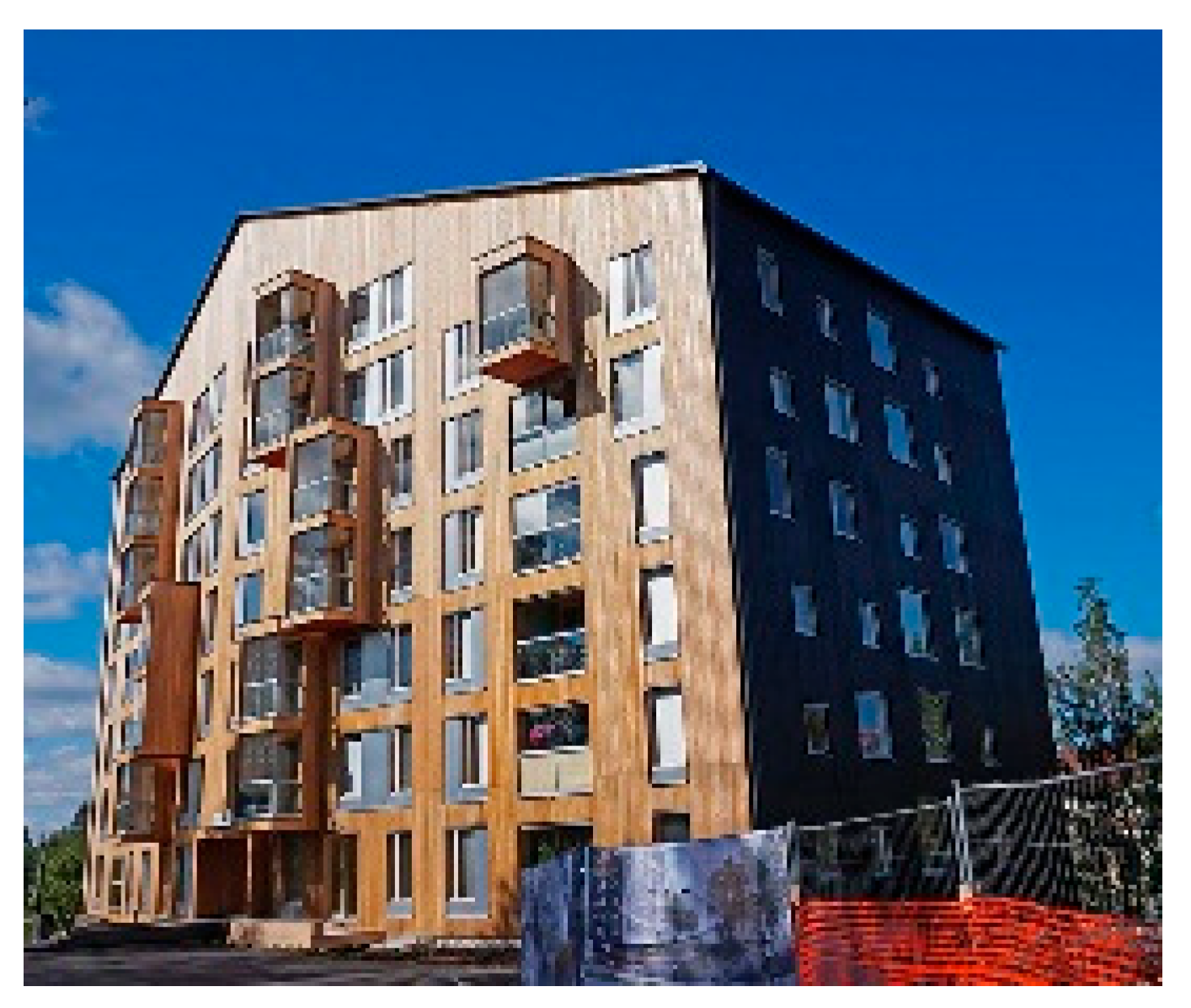
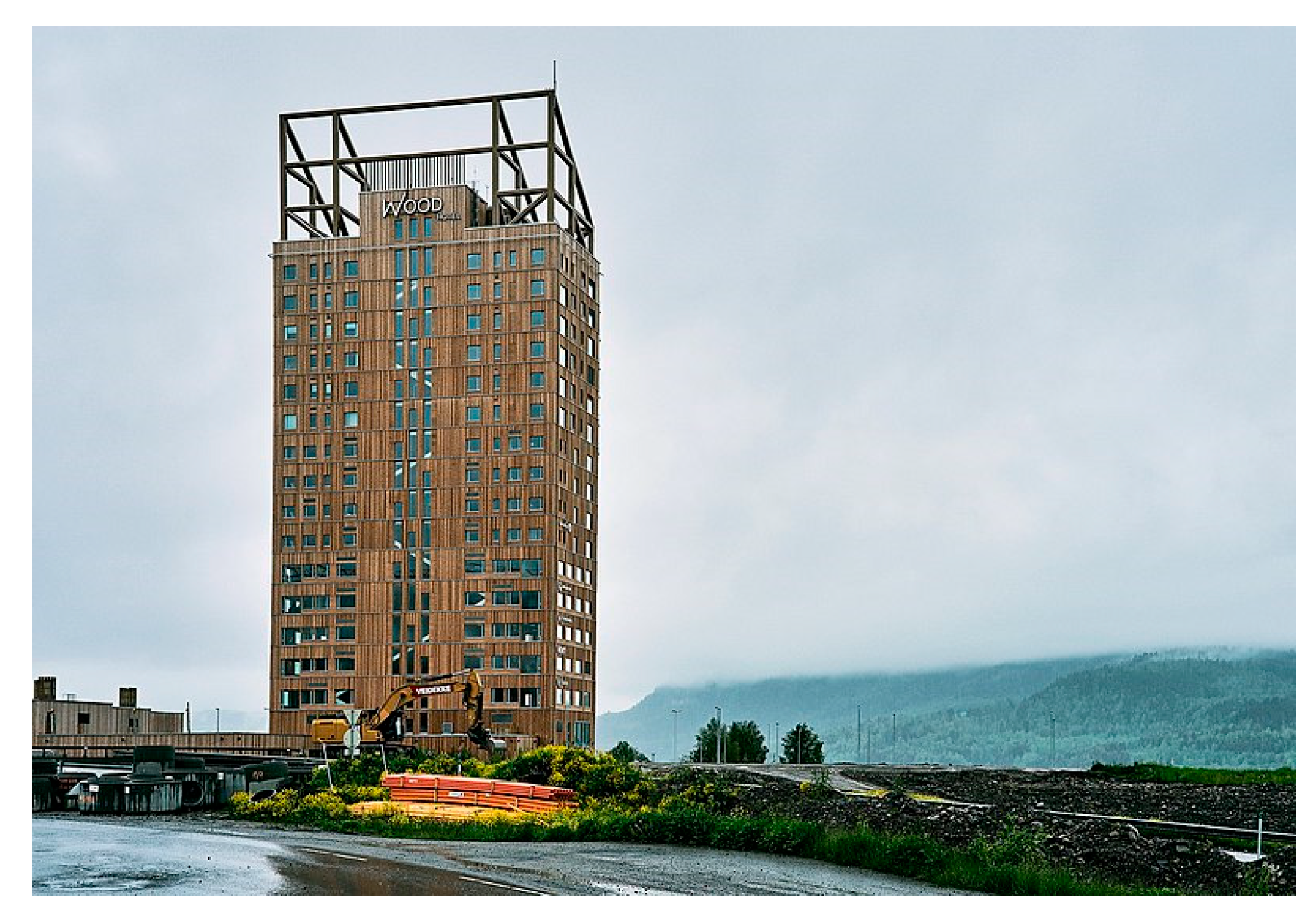

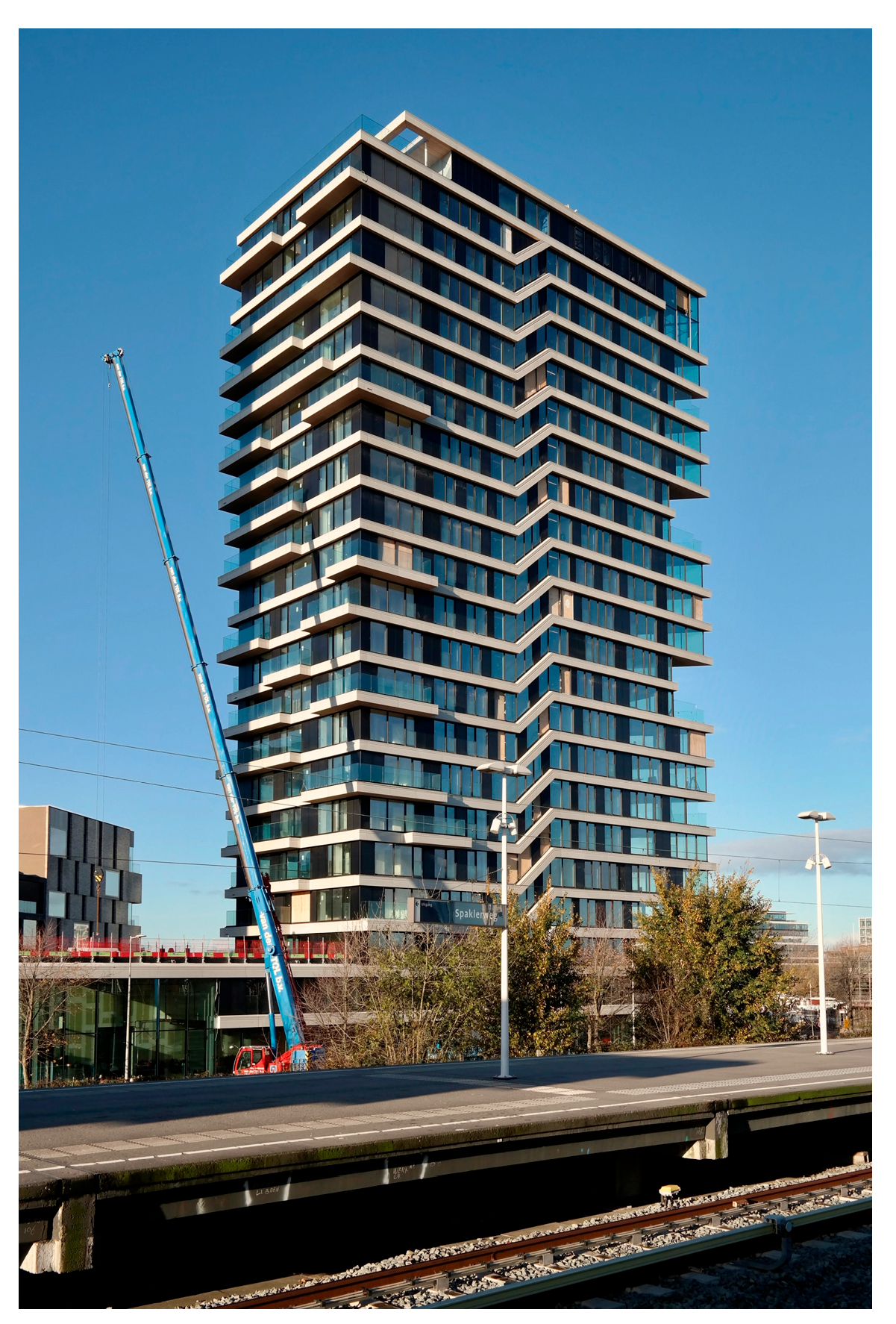
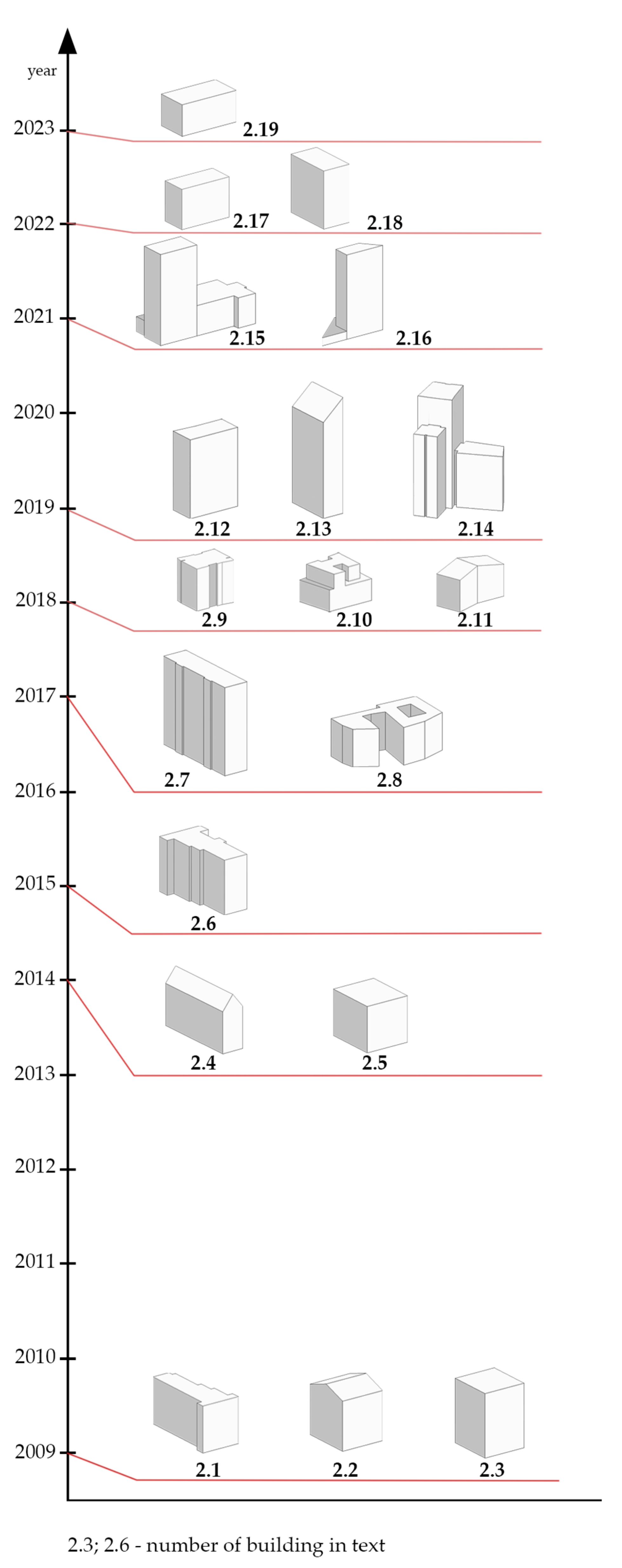
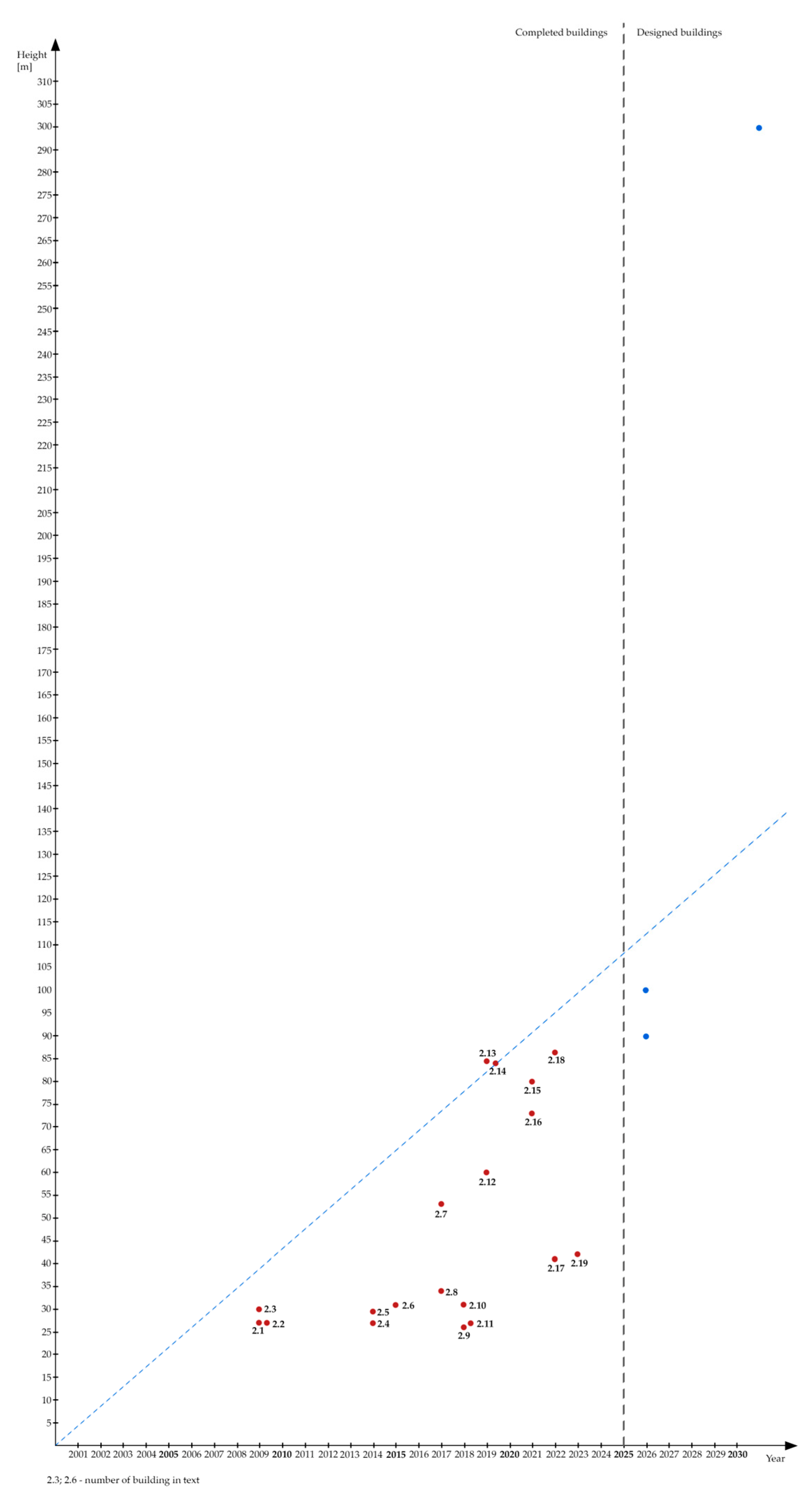
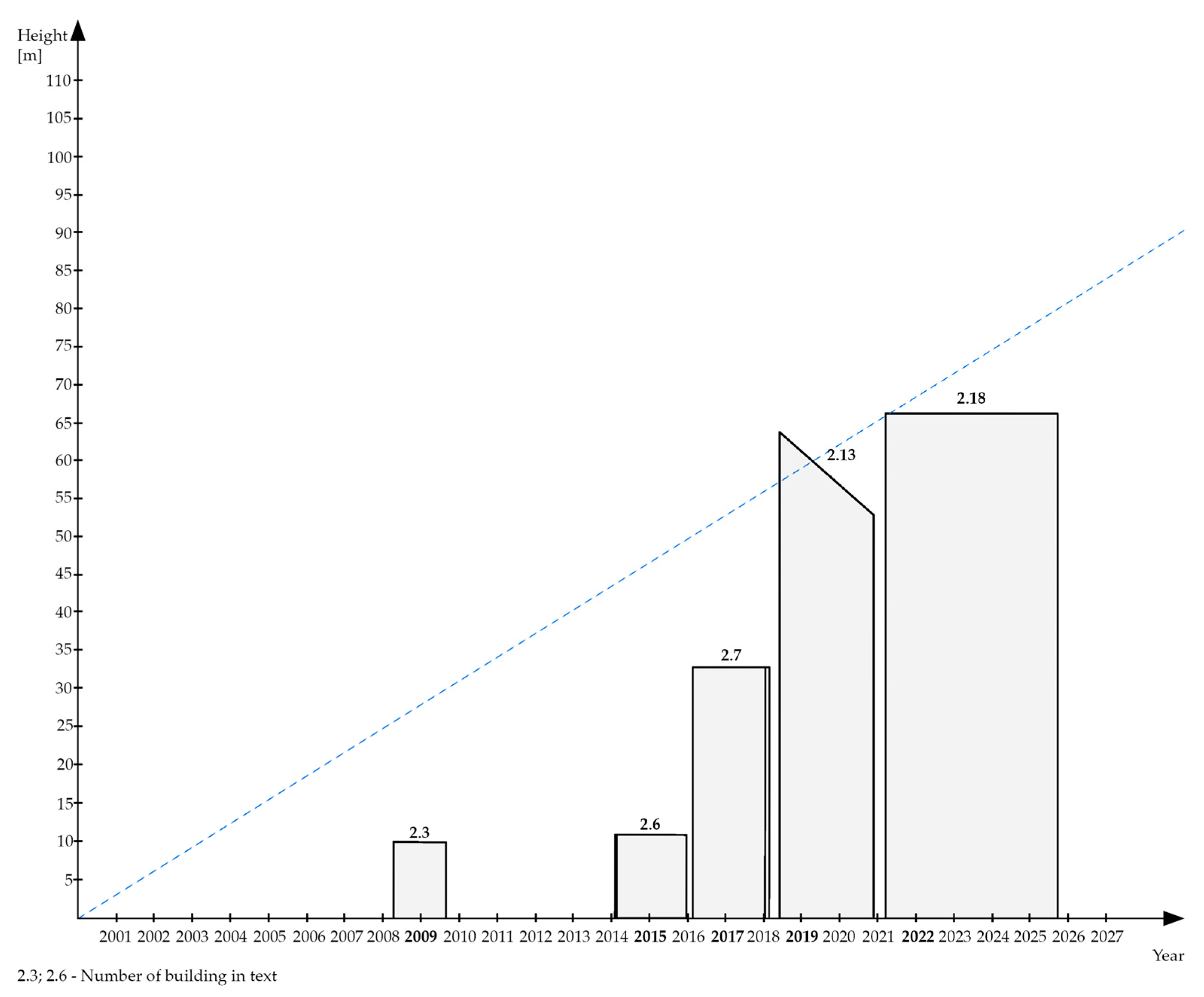
| No | Name of Building | Architecture Designer | Height (m) | Type of Function | Shape of the Building Body and Roof Shape | Shape of the Building Plan | Interior Decoration/Wall/Ceilings Coverings | External Decoration—Façades |
|---|---|---|---|---|---|---|---|---|
| 2.1 | Limnologen (four buildings) | ArkitektBolaget | 27.0 | Residential. | Rectangular; flat roof. | Rectangle | CLT wood panels. | CLT panels with façade cladding and plaster. |
| 2.2 | Portvakten Söder | – | 27.0 | Residential. | Rectangular; pitched roof. | Rectangle | Plasterboard. | CLT panels with façade cladding and plaster. |
| 2.3 | Stadthaus | Waugh Thistleton Architects | 30.0 | Residential with services on the ground floor. | Rectangular; flat roof. | Square | CLT wood panels or plasterboard. | Painted wooden cladding. |
| 2.4 | Strandparken Building B | Wingårdh Arkitektkontor | 27.0 | Residential. | Rectangular; pitched roof. | Rectangle | CLT wood panels or plasterboard. | Cedar wood shingles. |
| 2.5 | Wood Innovation Design Centre | Michael Green Architecture | 29.5 | Public utility building. | Rectangular; flat roof. | Rectangle | Dominant—CLT wood panels or GLT wood. | Glass curtain wall; LVL mullions. |
| 2.6 | Vallen | Arkitektbolaget | 31.0 | Residential. | Composed of cuboids and flat or pitched roofs. | Composed of rectangles | – | Wooden cladding; cedar wood shingles or plaster. |
| 2.7 | Brock Commons Tallwood House | Acton Ostry Architects Inc. | 53.0 | Ground floor: shared space. other above-ground: residential floors. | Rectangular; flat roof. | Rectangle | Plasterboard, wood, or concrete surface cladding. | Glass curtain wall with wooden elements. |
| 2.8 | Dalston Works | Waugh Thistleton Architects | 34.0 | Residential with services at ground floor level. | Composed of cuboids/flat roofs. | Composed of rectangles | Plasterboard; wood cladding. | Brick façade cladding. |
| 2.9 | Carbon12 | PATH Architecture | 26.0 | Residential and at ground floor level: shops. | Rectangular/flat roof. | Rectangle | Dominant—CLT wood panels or GLT wood. | Glass curtain wall on the south and north elevations and other “green walls” with climbing plants. |
| 2.10 | Immeuble ‘Perspective’ | Laisné, Roussel architectes | 31.0 | Office. | Composed of cuboidal blocks of different heights/flat roofs. | Quadrilateral | Dominant—CLT or GLT timber panels; concrete surfaces. | Glass curtain wall with wooden elements. |
| 2.11 | Puukuokka One, Two, Tree | OOPEAA | 27.0 | Residential. | Composed of two quadrilateral prisms/pitched roof. | Composed of two quadrilaterals | Predominantly wooden CLT or plasterboard panels. | Wooden cladding. |
| 2.12 | Arbo | Manetsch Meyer Architects | 60.0 | Office. | Perpendicular/flat roof. | Rectangle | Mixed finish/wood; concrete surface; metal. | Glass curtain wall. |
| 2.13 | Mjøstårnet | Voll Arkitekter | 84.5 | Residential and public uses—offices, hotels, restaurants, conference rooms, swimming pool, etc. | Rectangular/flat roof. | Rectangle | Varied finish. | Wood panels. |
| 2.14 | HoHo Vienna | Rüdiger Lainer and Partner ZT GmbH | 84.0 | Services and residential. | Composed of three cuboids/flat roof. | Composed of three rectangles | Dominant—CLT wood panels or GLT wood. | Wooden cladding. |
| 2.15 | Sara Kulturhus Center | White Arkitekter | 80.0 | Public utility—hotels, conference rooms, museums, restaurants, spa facilities, etc. | Composed of multiple perpendiculars/flat roof. | Composed of multiple rectangles | Wood panels. | Glass curtain wall with wooden elements. |
| 2.16 | Haut | Team V Architecture | 73.0 | Residential with services at ground floor level. | Quadrilateral prism/flat roof. | Rectangular trapezoid | Dominant—CLT wood panels. | Glass curtain wall or wood. |
| 2.17 | Tallwood I | Jack James Architecture | 41.0 | Residential with services at ground floor level. | Perpendicular/flat roof and above part of building flat pitched roof. | Rectangle | Dominant—CLT wood panels or GLT wood. | Diverse cladding, including wood. |
| 2.18 | Ascent MKE | Korb and Associates | 86.6 | Residential with public utility—services, retail, and recreation. | Rectangular/flat roof. | Rectangle | Dominant—CLT wood panels or GLT wood. | Glass curtain wall. |
| 2.19 | T3 Bayside | 3XN | 42.0 | Office. | Perpendicular/flat roof. | Rectangle | Dominant—CLT wood panels or GLT wood. | Glass curtain wall with wooden elements. |
| No | Name | Structure Designer | Foundation/Underground Floor Construction | Construction Type of the Above-Ground Part | Load-Bearing Wall/Post Construction | Ceiling Construction | Construction of Vertical Communication Structures |
|---|---|---|---|---|---|---|---|
| 2.1 | Limnologen | Martinsons Byggsystem (woodproducts), Tyréns (concrete) | Intermediate foundation on piles. | First storey above ground—reinforced concrete frame above, timber-framed wall system (locally timber-framed). | Walls made of prefabricated CLT panels, according to the Martinsons system (locally framed layout with GLT). | Slab ceilings of 3-layer CLT based on GLT beams. | Monolithic reinforced concrete. |
| 2.2 | Portvakten Söder | – | Direct foundation on reinforced concrete foundation slab. | First storey above ground—reinforced concrete frame; above, timber-framed wall system. | Walls made of prefabricated CLT panels, according to the Martinsons system. | Slab ceilings made of 3-layer CLT, according to the Martinsons system. | – |
| 2.3 | Stadthaus | Techniker Ltd. | – | Wooden wall bearing system. | Walls made of prefabricated CLT panels, according to the KLH system. | CLT panelled ceilings. | Walls made of prefabricated CLT panels, according to the KLH system. |
| 2.4 | Strandparken Building B | Martinsons (wood floors 2–9); Tyréns (concrete floor 1 and geotechnical engineering) | Foundations and structure of underground part—prefabricated reinforced concrete. | Wooden wall bearing system. | Walls made of prefabricated CLT panels, according to the Martinsons system. | Slab ceilings with CLT panels, according to the Martinsons system. | CLT panelled walls. |
| 2.5 | Wood Innovation Design Centre | Equilibrium Consulting | Direct foundation on reinforced concrete ribbed foundation slab. | Timber frame post-and-beam construction. | GLT timber posts. | CLT panelled ceilings based on GLT beams. | Stairway walls and slabs made of CLT panels. |
| 2.6 | Vallen | – | Foundation—reinforced concrete structure. | Storeys 1 and 2 above ground—post-and-beam reinforced concrete frame construction. Above—Trä8 timber frame load-bearing structure. | GLT timber posts. | GLT timber frame transoms; CLT ceiling panels. | Reinforced concrete walls. |
| 2.7 | Brock Commons Tallwood House | Fast and Epp Structural Engineers | Foundation—reinforced concrete structure. | Reinforced concrete structure at ground floor level, and timber post-and-beam structure above. | GLT timber posts. | 5-layer CLT ceiling panels. | Monolithic reinforced concrete. |
| 2.8 | Dalston Works | Ramboll (CLT and façade), PJCE (concrete and civils) | Direct foundation on reinforced concrete foundation slab. | Reinforced concrete frame structure at ground floor level, and timber wall structure above. | Walls made of prefabricated CLT panels. | Prefabricated CLT panel ceiling slabs. | Stairway walls and panels of prefabricated CLT panels. |
| 2.9 | Carbon12 | Munzing Structural Engineering, LLC | Foundation on a reinforced concrete foundation slab; underground storey construction—reinforced concrete frame. | Reinforced concrete structure at ground floor level, and timber frame structure above. | GLT posts; CLT walls. | GLT timber ceiling beams; CLT panelled ceiling slabs. | – |
| 2.10 | Immeuble ‘Perspective’ | – | Foundation—monolithic reinforced concrete construction. | Timber post-and-beam bearing system. | GLT posts. | CLT ceiling slabs based on GLT beams. | Monolithic reinforced concrete construction. |
| 2.11 | Puukuokka One | Pertti Ruuskanen Oy, SWECO rakennetekniikka Oy and A-Insinöörit Oy | Reinforced concrete monolithic foundation and underground construction. | Load-bearing system assembled from prefabricated timber spatial modules. | Prefabricated spatial modules (ceilings and walls) in CLT wood. | Prefabricated spatial modules (ceilings and walls) in CLT wood. | – |
| 2.12 | Arbo | – | Reinforced concrete monolithic structure of the foundations and two underground storeys. | Timber frame post-and-beam construction. | GLT or LVL timber posts. | TCC prefabricated timber/concrete floors supported on GLT beams. | Monolithic reinforced concrete construction. |
| 2.13 | Mjøstårnet | Moelven Limtre, Sweco | Intermediate foundation on a pile-supported reinforced concrete slab. | Timber frame post-and-beam structure. | GLT posts. | Storeys 12–18: reinforced concrete slab ceilings supported on GLT beams; storeys 2–11: ceilings of CLT panels, according to the Trä8 system on GLT beams. | CLT walls. |
| 2.14 | HoHo Vienna | HoHo Vienna | Reinforced concrete foundations and construction of two underground floors. | Timber post-and-beam load-bearing structure. | GLT posts; CLT external walls. | Composite wood–concrete (CLT)—ceiling supported on GLT beams. | Construction of vertical communication structures and stairways—reinforced concrete. |
| 2.15 | Sara Kulturhus Center | Dipl.-Ing. Florian Kosche AS | Intermediate foundation on piles topped by a reinforced concrete slab. | Load-bearing structure assembled from prefabricated CLT spatial modules. | CLT prefabricated spatial modules (walls and ceilings). | CLT prefabricated spatial modules (walls and ceilings). | CLT vertical communication structures and lift shafts. |
| 2.16 | Haut | Arup | Intermediate foundation on diaphragm walls and Tubex foundation piles and two-storey underground structure—monolithic reinforced concrete. | Reinforced concrete monolithic structure of the two lower storeys above ground; above: timber–concrete hybrid wall system. | CLT walls. | TCC concrete/wood hybrid panel floors. | Vertical communication structures: monolithic reinforced concrete. |
| 2.17 | Tallwood I | Aspect Structural Engineers | Foundations and construction of two underground floors—monolithic reinforced concrete structure. | Ground floor construction—reinforced concrete monolithic post and slab structure; above, steel and timber hybrid frames. | GLT posts and steel stiffening frames of I sections. | Ceiling slabs made of 5-layer CLT panels based on GLT beams | Vertical communication structures: monolithic reinforced concrete |
| 2.18 | Ascent MKE | Thornton Tomasetti | Indirect foundation on piles. | Construction of the six lower floors—monolithic reinforced concrete frame with pre-stressed concrete floors; timber beam-and-post construction above. | GLT posts. | CLT panelled ceilings | Vertical communication structure and lift shaft: monolithic reinforced concrete |
| 2.19 | T3 Bayside | WSP Denmark A/S | Intermediate foundation on foundation piles; structure of underground storey—monolithic reinforced concrete. | Reinforced concrete monolithic ground floor structure; timber post-and-beam frame above. | GLT posts. | Ceiling slabs made of 7-layer CLT panels based on GLT beams | Vertical communication structures: monolithic reinforced concrete |
Disclaimer/Publisher’s Note: The statements, opinions and data contained in all publications are solely those of the individual author(s) and contributor(s) and not of MDPI and/or the editor(s). MDPI and/or the editor(s) disclaim responsibility for any injury to people or property resulting from any ideas, methods, instructions or products referred to in the content. |
© 2024 by the authors. Licensee MDPI, Basel, Switzerland. This article is an open access article distributed under the terms and conditions of the Creative Commons Attribution (CC BY) license (https://creativecommons.org/licenses/by/4.0/).
Share and Cite
Michalak, H.; Michalak, K. Selected Aspects of Sustainable Construction—Contemporary Opportunities for the Use of Timber in High and High-Rise Buildings. Energies 2024, 17, 1961. https://doi.org/10.3390/en17081961
Michalak H, Michalak K. Selected Aspects of Sustainable Construction—Contemporary Opportunities for the Use of Timber in High and High-Rise Buildings. Energies. 2024; 17(8):1961. https://doi.org/10.3390/en17081961
Chicago/Turabian StyleMichalak, Hanna, and Karolina Michalak. 2024. "Selected Aspects of Sustainable Construction—Contemporary Opportunities for the Use of Timber in High and High-Rise Buildings" Energies 17, no. 8: 1961. https://doi.org/10.3390/en17081961





